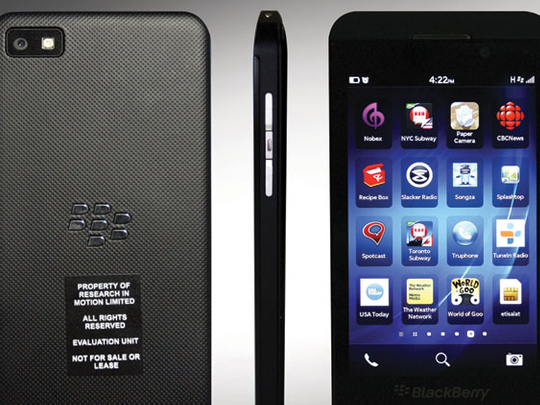
No one can say BlackBerry didn’t try. They’ve stuck it out for as long as they could, keeping their querty alive and typing, but the market had its final say, embracing touchscreens en masse. RIM has come around and now has finally launched their much awaited BlackBerry Z10. The new smartphone runs on QNX-based BB10 and known as Blackberry 10, has a 4.2-inch multi-touch LCD display with a resolution of 768 x 1280 pixels. This is the second time RIM comes out with a full touch screen. The earlier model was Torch 9860. Z10 is powered by 1.5GHz dual-core Qualcomm MSM8960 processor.
Light and sleek
The Z10 phone has dimensions of 130mm x 65.6mm x 9mm and it comes quite light, sleek and yes, it does look like an iPhone 5 and it comes in black or white.
The phone’s earpiece jack is at the top, which is also where the on/off power button are. On the right side are the volume up/down buttons and a button which can be used for voice control (Siri-like) or as a start/stop button when playing music or video. On the left are the mini HDMI port and the USB port.
The 4.2-inch multi-touch LCD display has a resolution of 768 x 1280 pixels, which translates into 355 pixels per inch which is greater than iPhone 5’s 326 pixels per inch. Nokia’s Lumia 920 has 332 pixels per inch density and the same pixel resolution as Z10. Samsung’s Galaxy S3 has a pixel density of 306ppi and 1280x720 pixel resolution.
This is the second time RIM is coming out with a full touch screen. The earlier model was Torch 9860. Z10 is powered by 1.5GHz dual-core Qualcomm MSM8960 processor. It has 2GB of RAM and 16GB of internal storage, plus microSD slot for additional storage expansion. It’s a shame that RIM came out with a dual-core processor at this juncture, which marks an attempt for a strong comeback into smartphone markets. Many competing vendors have already launched handsets with quad core processors.
New platform
The device is operated by a a new user interface and it can be controlled by gestures. It has no physical buttons on the phone. Getting used to the new user interface takes time and I also found it difficult to get used to the new platform. It took me two days to get the feel of the new platform. To access the phone, users need to swipe from the bottom up on the screen. There are five home screens and one for previously opened apps and one for BlackBerry Hub.
All BlackBerry Messenger texts, emails, voice and social media, contacts and BBM are managed through the BlackBerry Hub. The Blackberry Messenger has both voice and video chatting facilities, but it is yet to be known whether the telco operators in the UAE would allow it. Even the older version — BB7 — had voice chatting and the telco operators blocked it.
The icon-heavy applications grid is very similar to Apple’s iPhone. When running an app, users can slide down from the top to get other options and slide up from bottom to mimimise the application without actually closing it. It is a multi-tasking device and the apps run from the background. You can keep eight apps opened in the previously opened screen.
Without leaving an application, users can slide up from bottom a little to see emails, messages and social media notifications. Another feature which will appeal to the corporates is the “balance feature”. It allows separate private and business areas. You can have you own set of apps in different areas.
Predictive typing
The virtual keyboard has become smarter on Z10. It has the predictive typing facitlity and can also remember input styles. Browsing is faster than most phones we tried in the market. During my comparison tests with Apple’s iPhone 5, Nokia’s Lumia 920 and Samsung Galaxy S3, Z10 came out a clear winner. In the HTML 5 browser support test — html5test.com — iPhone 5 scored 386 points and Galaxy S3 scored 427 points while Lumia 920 only scored 320 points.
The Z10 scored 485 points. The Z10 phone also appeared to be a bit faster when opening pages compared to iPhone 5, Galaxy S3 and Lumia 920.
In the messaging mode, pressing a message for a few seconds opens a menu with nine options on the right side. The rear facing camera is 8MP with advanced features like autofocus, LED flash, geo tagging and 1080p (Full HD) video recording capability. It offers 5x digital zoom function.
Another interesting feature is the time shift, where you can take a series of pictures and then select the best one from the set. For video conferencing, the Z10 has a 2MP camera that can take video at 720p. It has 3 x digital zoom function. Regarding connectivity, Z10 has WiFi, Bluetooth 4.0 and NFC. But no 4G LTE for the region right now.
On the app front, BlackBerry lags behind many of its rivals. It is expected to have around 70,000 apps. Many are free and the paid apps range from $0.99 to $29.99. The 1800mAh battery life on Z10 is not that great. During my test, listening to songs, watching videos and surfing emails with 3G on, the device lasted for around 16 hours.











